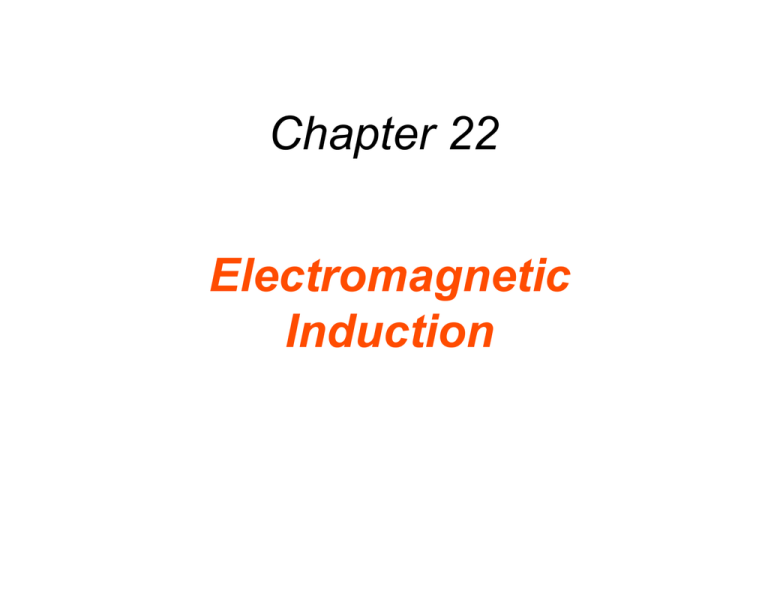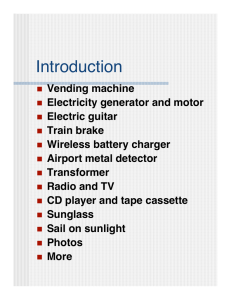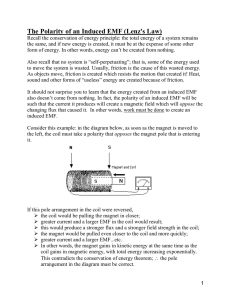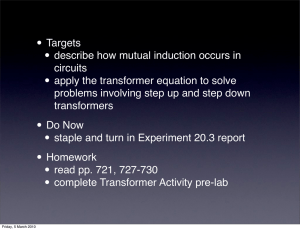Chapter 22 Electromagnetic Induction
advertisement

Chapter 22 Electromagnetic Induction 22.4 Faraday’s Law of Electromagnetic Induction FARADAY’S LAW OF ELECTROMAGNETIC INDUCTION The average emf induced in a coil of N loops is ) " # "o & !" $$ = # N E = # N '' E !t ( t # to % where, Φ = BA cos φ (The motional emf-Φ relation we derived is a special case of this.) the minus sign reminds us that the induced emf will oppose the change in Φ LENZ’S LAW SI Unit of Induced Emf: volt (V) Faraday’s law states that an emf is generated if the magnetic flux changes for any reason. Since Φ = BA cos φ, any change of B, A, or φ will induce an emf. 22.5 Lenz’s Law LENZ’S LAW The induced emf resulting from a changing magnetic flux has a polarity that leads to an induced current whose direction is such that the induced magnetic field opposes the original flux change. 22.5 Lenz’s Law LENZ’S LAW The induced emf resulting from a changing magnetic flux has a polarity that leads to an induced current whose direction is such that the induced magnetic field opposes the original flux change. Reasoning Strategy 1. Determine whether the magnetic flux that penetrates the coil is increasing or decreasing. 2. Find what the direction of the induced magnetic field must be so that it can oppose the change in flux by adding or subtracting from the original field. 3. Use RHR-2 to determine the direction of the induced current. 22.5 Lenz’s Law Conceptual Example 8 The Emf Produced by a Moving Magnet A permanent magnet is approaching a loop of wire. The external circuit consists of a resistance. Find the direction of the induced current and the polarity of the induced emf. Since the applied magnetic field in the loop is increasing and pointing to the right, Lenz’s law says an induced current will be created in the loop to try to oppose this change by creating an induced magnetic field to the left. 22.5 Lenz’s Law Conceptual Example 9 The Emf Produced by a Moving Copper Ring. There is a constant horizontal magnetic field directed into the page in the shaded region. The field is zero outside the shaded region. A copper ring is dropped vertically through the region. For each of the five positions, determine whether an induced current exists and, if so, find its direction. Is the acceleration of the ring the same as it drops through the five positions? Electric generators A battery converts chemical energy into electrical energy to produce currents and voltages in circuits. An electric generator uses Faraday’s Law to convert mechanical energy into electrical energy. Most of the electric power in the world is produced by electric generators! (e.g. the 120 V out of your electrical outlet) 22.7 The Electric Generator HOW AN ELECTRIC GENERATOR PRODUCES AN EMF An electric generator has essentially the same configuration as an electric motor, it is just used differently, i.e., motor: I mechanical energy generator: mechanical energy I 22.7 The Electric Generator Equation for the emf, E, induced in a rotating planar coil For a coil of N loops , loop area, A (valid for any planar shape), turning at a rotational frequency, f, in a magnetic field, B, E = NABω sin ωt = E0 sin ωt ω = 2 πf angular frequency in radians/sec 22.7 The Electric Generator E = E0 sin ωt , E0 = NABω , maximum emf emf from generators is sinusoidal in time alternating current (ac) T = period = 1/f = 2π/ω Example. A generator with a circular coil of 75 turns of area 3.0 x 10-2 m2 is immersed in a 0.20 T magnetic field and rotated with a frequency of 60 Hz. Find the maximum emf which is produced during a cycle. Solution: The maximum emf for a generator is E0 = NABω We know N = 75, A = 3.0 x 10-2 m2, B = 0.20 T and f = 60 Hz . Since ω = 2πf = 2π(60) = 377 radians/s E0 = (75)(3.0 x 10-2)(0.20)(377) = 170 V 22.9 Transformers A transformer is a device for increasing or decreasing an ac voltage. It works on the principle of Faraday’s Law. Vs Vp Vp = -Np ΔΦ/Δt Dividing Vs by Vp cancels out ΔΦ/Δt since it is the same for the primary and secondary coils. Vs = -Ns ΔΦ/Δt Vs N s = Vp N p Transformer equation 22.9 Transformers Vs N s = Vp N p Vs = (Ns/Np) Vp Ns > N p V s > V p Ns < N p V s < V p step-up transformer step-down transformer From conservation of energy, the power must be conserved, Pp = P s I p V p = I s V s I s Vp N p = = I p Vs Ns A transformer that steps up the voltage simultaneously steps down the current, and a transformer that steps down the voltage steps up the current. Example. A certain transformer has 30 turns in is primary coil and 500 turns in its secondary coil. If a 12 V ac source is attached to the primary and 4.0 A is flowing in it, find the voltage and current in the secondary coil. Solution. Use the transformer equation I s Vp N p = = I p Vs Ns Vs = (Ns/Np) Vp = (500/30)(12) = 200 V step-up voltage Is = (Np/Ns) Ip = (30/500)(4) = 0.24 A step-down current Is the power delivered to the secondary coil equal to the power sent to the primary coil? Pp = IpVp = (4)(12) = 48 W , Ps = IsVs = (0.24)(200) = 48 W 16.1 The Nature of Waves Since we will be studying electromagnetic waves, let’s review some general features of waves: 1. A wave is a traveling disturbance. 2. A wave carries energy from place to place. 16.1 The Nature of Waves Longitudinal Wave - the “disturbance” caused by the wave moves along the direction that the wave propagates, e.g., sound waves, “compressed slinky waves”…… 16.1 The Nature of Waves Transverse Wave - the “disturbance” caused by the wave moves perpendicular to the direction that the wave propagates, e.g., water waves, “shaken slinky waves”, electromagnetic waves…. 16.2 Periodic Waves Periodic waves consist of cycles or patterns that are produced over and over again by the source. In the figures, every segment of the slinky vibrates in a simple harmonic motion, provided the end of the slinky is moved in a simple harmonic motion. 16.2 Periodic Waves In the drawing, one cycle is shaded in color. The amplitude A is the maximum excursion of a particle of the medium from the particles undisturbed position. The wavelength is the horizontal length of one cycle of the wave. The period is the time required for one complete cycle. The frequency is the number of cycles per time. It is related to the period and has units of Hz, or s-1. 1 f = T 16.2 Periodic Waves The propagation velocity of a periodic wave is related to its frequency and wavelength. Consider the motion of a long train as a periodic wave which repeats itself with the passing of each identical car: Since velocity is distance/time ! v = = f! T






